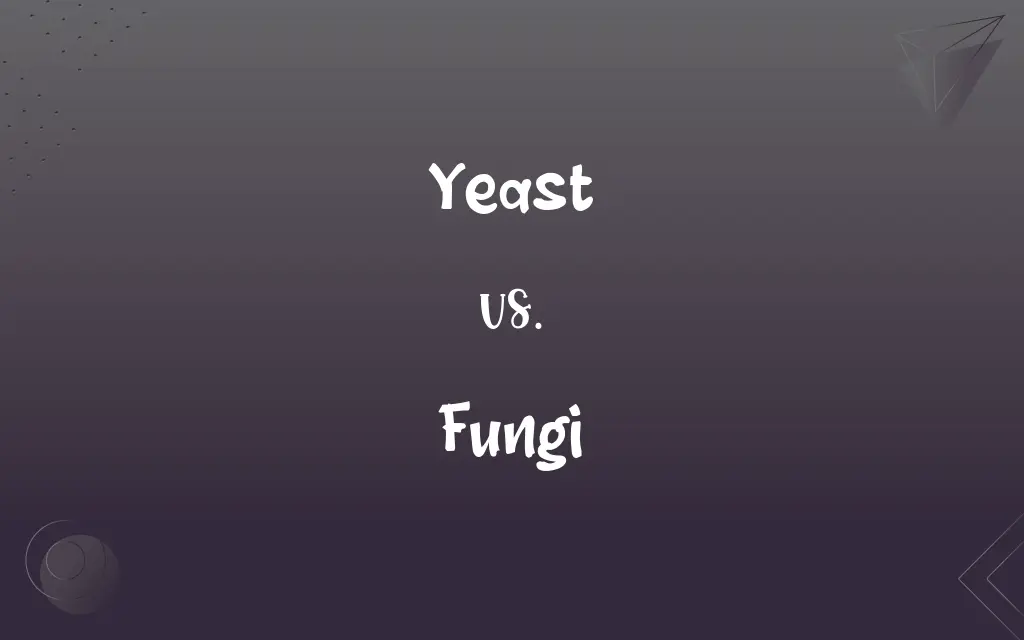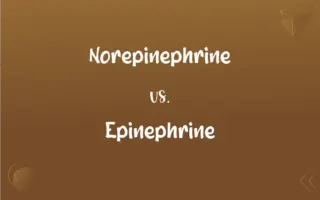Yeast vs. Fungi: What's the Difference?
Edited by Harlon Moss || By Janet White || Published on August 25, 2024
Yeast are single-celled fungi used in fermentation and baking; fungi is a kingdom including molds, mushrooms, and yeasts, diverse in form and ecology.

Key Differences
Yeast and fungi are both important in various ecological and industrial processes. Yeast, a unicellular organism, plays a crucial role in fermentation, converting sugars into alcohol and carbon dioxide. Fungi, a broader kingdom, encompasses a wide range of organisms, including yeasts, molds, and mushrooms. These organisms are essential decomposers in ecosystems, breaking down organic matter.
Yeast is primarily known for its role in baking and brewing, contributing to the rise of bread and the production of alcoholic beverages, fungi have a more diverse set of roles. Fungi can be pathogenic, causing diseases in plants and animals, but they also form symbiotic relationships with plants, enhancing nutrient uptake. Yeast, as a subset of fungi, showcases the versatility within the fungal kingdom, being beneficial in food production and biotechnology.
Yeast reproduces asexually through budding or fission, whereas fungi reproduce through a variety of complex life cycles, including both sexual and asexual reproduction. The simplicity of yeast reproduction makes it a valuable tool in genetic studies and biotechnology. In contrast, the reproductive diversity of fungi contributes to their widespread distribution and ecological adaptability.
In terms of habitat, yeast is commonly found in moist, nutrient-rich environments, such as on the skins of fruits and in the nectar of flowers. Fungi, on the other hand, inhabit a broad range of environments, from soil and water to living on or inside plants and animals. This adaptability allows fungi to play key roles in nutrient cycling and ecosystem functioning.
The study of yeast, known as zymology, focuses on the biochemical processes and industrial applications of these organisms. Mycology, the study of fungi, covers a broader spectrum, examining the taxonomy, genetics, and ecological roles of all fungal species. This distinction highlights the specialized nature of yeast within the fungal kingdom and the wide-ranging impact of fungi on the environment and human industry.
ADVERTISEMENT
Comparison Chart
Cellular Structure
Single-celled
Mostly multicellular, some unicellular
Reproduction
Asexual (budding, fission)
Both sexual and asexual methods
Role in Nature
Fermentation, baking
Decomposers, symbionts, pathogens
Industrial Use
Brewing, biofuel production
Antibiotics, food (mushrooms)
Study
Zymology
Mycology
ADVERTISEMENT
Yeast and Fungi Definitions
Yeast
Yeast causes dough to rise by producing carbon dioxide.
I added yeast to my bread dough to make it fluffy.
Fungi
Fungi are sources of antibiotics, like penicillin.
The fungus Penicillium revolutionized medicine by producing penicillin.
Yeast
Yeast serves as a model organism in genetic studies.
Scientists use yeast to understand gene function and regulation.
Fungi
Fungi break down dead organic matter, recycling nutrients back into ecosystems.
Fungi decompose fallen leaves, enriching the soil.
Yeast
Yeast is utilized in the production of biofuels through the fermentation process.
Yeast is key in converting biomass into sustainable biofuel.
Fungi
Some fungi cause diseases in plants and animals.
Rust fungi infect wheat crops, causing significant yield losses.
Yeast
Yeast is a microorganism used in fermentation to produce alcohol and carbon dioxide.
Yeast transforms sugar into beer through fermentation.
Fungi
Fungi form symbiotic relationships with plants, enhancing nutrient absorption.
Mycorrhizal fungi increase nutrient uptake for trees.
Yeast
Yeast supplements can support gut health.
Yeast-based probiotics help maintain my digestive balance.
Fungi
Many fungi, such as mushrooms, are edible and nutritious.
Mushrooms, a type of fungi, are a delicious addition to meals.
Yeast
Any of various unicellular fungi of the genus Saccharomyces, especially S. cerevisiae, reproducing asexually by budding or sexually through the production of ascospores and capable of fermenting carbohydrates.
FAQs
What is yeast?
Yeast is a single-celled fungus used in fermentation and baking.
How does yeast reproduce?
Yeast reproduces asexually through budding or fission.
What are fungi?
Fungi is a kingdom of organisms that includes yeasts, molds, and mushrooms, diverse in form and function.
Can yeast cause infections?
Yes, some yeast species can cause infections in humans, such as Candida.
How do fungi reproduce?
Fungi reproduce through both sexual and asexual methods, depending on the species.
Is yeast used in brewing?
Yes, yeast is essential in brewing for alcohol production through fermentation.
Can fungi be eaten?
Yes, many fungi, like mushrooms, are edible and nutritious.
What ecological role do fungi play?
Fungi act as decomposers, symbionts, and sometimes pathogens, playing key roles in nutrient cycling.
What benefits do yeast offer in food production?
Yeast is crucial in baking, brewing, and winemaking for fermentation.
Can fungi grow in water?
Yes, some fungi are aquatic and play roles in decomposing organic matter in water.
Are all fungi harmful?
No, while some fungi are pathogens, many play beneficial roles in ecosystems and as food sources.
What is the role of yeast in bread making?
Yeast causes dough to rise by producing carbon dioxide during fermentation.
Is yeast considered a plant?
No, yeast is a fungus, not a plant.
How are yeast and fungi studied?
Yeast is studied in zymology, while fungi are studied in mycology.
Are yeast infections treatable?
Yes, yeast infections can be treated with antifungal medications.
How do fungi affect human health?
Some fungi cause diseases, while others produce antibiotics or are used as probiotics.
What distinguishes yeast from other fungi?
Yeast is unicellular, while most fungi are multicellular.
How do fungi contribute to agriculture?
Fungi can enhance crop growth through symbiotic relationships and are also a source of antibiotics.
Can yeast be used in genetic research?
Yes, yeast is a model organism in genetic studies due to its simple genetics and rapid growth.
What is the significance of yeast in biofuel production?
Yeast converts sugars into ethanol, a sustainable biofuel, through fermentation.
About Author
Written by
Janet WhiteJanet White has been an esteemed writer and blogger for Difference Wiki. Holding a Master's degree in Science and Medical Journalism from the prestigious Boston University, she has consistently demonstrated her expertise and passion for her field. When she's not immersed in her work, Janet relishes her time exercising, delving into a good book, and cherishing moments with friends and family.
Edited by
Harlon MossHarlon is a seasoned quality moderator and accomplished content writer for Difference Wiki. An alumnus of the prestigious University of California, he earned his degree in Computer Science. Leveraging his academic background, Harlon brings a meticulous and informed perspective to his work, ensuring content accuracy and excellence.






































































